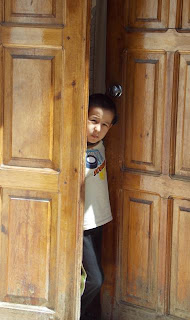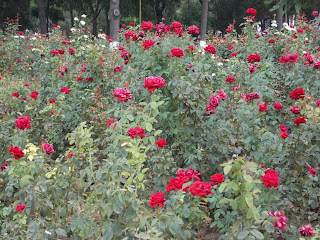Uzbekistan, a country of 447000 sq.km
and over 26 million inhabitants, occupied the central part of Central Asia, in
a region forming the so called Turkestan. Inhabited since immemorial times,
this territory witnessed the campaigns of Alexander the Great, was conquered by
Arabs in the 7th-8th centuries (who brought here Islam, which took the place of
Buddhism), was invaded by the Mongol hoardes of Genghis Han in the 13th
century, and then (14th century) has seen the increase of the Timur’s empire. Between the 16th-19th
centuries the territory was dominated by the three khanates of Khiva, Bukhara
and Kokand. Starting the second part of the 19th century, it was
conquered by the tsar Russia, which transformed it into protectorate, its
capital at Tashkent. Uzbekistan was created in 1924, and it took the same course
as the other former Soviet republics, as part of the Soviet Union. On 1st September
1991 it declared its independence.
The great richnesses, which attracted so many conquerers, are cotton, gold, uranium and natural gas.
Tashkent, the antique town built on the Silk Road, was almost completely destroyed by an earthquake, on 1966. It was reconstructed with help of the other Soviet republics, which sent here their best architects. Their influence in constructions are still to be seen in the block of flats, called by the locals “hruschiovka”
There are new and modern buildings as well, and also a small part of the old Tashkent remained. So, everybody has something to see in Tashkent. We were amazed to see how many parks and fountains they have there! It is a green, lovely city!
From our hotel window, we saw the big Amir Temur Square. In a single day one cannot see so many things, so we planned to go and see what it is possible at walking distance, before to begin the tour, the next day. What we saw, follows in the next episodes.
Uzbekistanul, o tara care se intinde pe o suprafata de mai bine de 447000 km patrati si are o populatie de peste 26 milioane de oameni, ocupa chiar centrul Asiei Centrale, zona cunoscuta in istorie ca Turkestan. Locuit din timpuri stravechi, acest pamant a fost martorul campaniilor lui Alexandru cel Mare, apoi a fost stapanit de arabi in secolele 7-8 (cand budhismul a fost inlocuit treptat de islamism), invadat de hoardele mongole ale lui Genghis Han in secolul al 13-lea si martorul cresterii imperiului lui Timur, un secol mai tarziu. Intre secolele 16-19 a fost dominat de cele trei khanate: Khiva, Bukhara si Kokand, pentru ca in a doua jumatate a secolului al 19-lea acestea sa fie cucerite de Rusia tarista. Aceasta le-a transformat in protectorat, cu capitala la Tashkent. Dupa revolte si scurte perioade de oarecare independenta, in 1924 a fost creat Uzbekistanul, ca parte a Uniunii Sovietice, urmand cursul celorlalte republici similare. Si-a declarat independenta in 1991. Marile sale bogatii, ravnite de atatia cuceritori, sunt bumbacul, aurul, uraniul si gazele naturale.
Tashkentul, oras antic aflat pe Drumul Matasii, a fost distrus aproape in intregime de un cutremur, in anul 1966. Reconstruit atunci cu ajutor sosit din intreaga Uniune Sovietica, care si-a pus la dispozitie cei mai buni arhitecti, orasul mai prezinta inca influenta sovietica a constructiilor, in special in blocurile din partea numita de localnici "hrusciovka".
Astfel, fiecare are cate ceva de vazut in Tashkent. Ceea ce ne-a uimit pe noi a fost numarul mare de parcuri, iarba verde (stropita continuu aproape) si numarul mare de fantani.
De la fereastra camerei de hotel cuprindem cu privirea intreaga Piata Amir Temur.
The great richnesses, which attracted so many conquerers, are cotton, gold, uranium and natural gas.
Tashkent, the antique town built on the Silk Road, was almost completely destroyed by an earthquake, on 1966. It was reconstructed with help of the other Soviet republics, which sent here their best architects. Their influence in constructions are still to be seen in the block of flats, called by the locals “hruschiovka”
There are new and modern buildings as well, and also a small part of the old Tashkent remained. So, everybody has something to see in Tashkent. We were amazed to see how many parks and fountains they have there! It is a green, lovely city!
From our hotel window, we saw the big Amir Temur Square. In a single day one cannot see so many things, so we planned to go and see what it is possible at walking distance, before to begin the tour, the next day. What we saw, follows in the next episodes.
Uzbekistanul, o tara care se intinde pe o suprafata de mai bine de 447000 km patrati si are o populatie de peste 26 milioane de oameni, ocupa chiar centrul Asiei Centrale, zona cunoscuta in istorie ca Turkestan. Locuit din timpuri stravechi, acest pamant a fost martorul campaniilor lui Alexandru cel Mare, apoi a fost stapanit de arabi in secolele 7-8 (cand budhismul a fost inlocuit treptat de islamism), invadat de hoardele mongole ale lui Genghis Han in secolul al 13-lea si martorul cresterii imperiului lui Timur, un secol mai tarziu. Intre secolele 16-19 a fost dominat de cele trei khanate: Khiva, Bukhara si Kokand, pentru ca in a doua jumatate a secolului al 19-lea acestea sa fie cucerite de Rusia tarista. Aceasta le-a transformat in protectorat, cu capitala la Tashkent. Dupa revolte si scurte perioade de oarecare independenta, in 1924 a fost creat Uzbekistanul, ca parte a Uniunii Sovietice, urmand cursul celorlalte republici similare. Si-a declarat independenta in 1991. Marile sale bogatii, ravnite de atatia cuceritori, sunt bumbacul, aurul, uraniul si gazele naturale.
Tashkentul, oras antic aflat pe Drumul Matasii, a fost distrus aproape in intregime de un cutremur, in anul 1966. Reconstruit atunci cu ajutor sosit din intreaga Uniune Sovietica, care si-a pus la dispozitie cei mai buni arhitecti, orasul mai prezinta inca influenta sovietica a constructiilor, in special in blocurile din partea numita de localnici "hrusciovka".
blocuri vechi, de tip sovietic
Exista si multe constructii noi, moderne
noul stadion national
si s-a pastrat si o mica zona din orasul vechi.Astfel, fiecare are cate ceva de vazut in Tashkent. Ceea ce ne-a uimit pe noi a fost numarul mare de parcuri, iarba verde (stropita continuu aproape) si numarul mare de fantani.
De la fereastra camerei de hotel cuprindem cu privirea intreaga Piata Amir Temur.
de la fereastra camerei, piata larga Amir Temur
Intr-o zi nu poti vedea foarte multe dar iti poti face totusi o parere despre un oras. Traseul pe care l-am facut pentru plimbarea noastra dinainte de intrarea in program cuprinde zone invecinate hotelului, pe care le-am putut strabate cu piciorul. Metroul l-am folosit doar in jumatatea de zi de la terminarea turului, cand am vizitat (tot singure) Turnul TV. Detalii despre plimbare, in episodul urmator.


















14 comments:
You have another great documentary of this city. I see the buildings than many decorations. Also, you have to press attention given e nature. A blog with beautiful photos and lots of information again :-)
Greetings, Helma
Very strange places!
Thank you, Helma, for your comment!
It's a mixture of styles and ages, VP. But the general impression is that of a very nice city, you will see.
I like the photo of the little boy.
The last piece is cool !
He invited us to see his house, Randy! A cute little boy, indeed.
It wastaken from our hotel room, Wong. Thanks!
Intr-adevar un oras verde. Mi-as fi dorit muuulte ore de plimbare in parcurile de-acolo. Trebuie, ca au trandafiri frumosi ...
Trandafirii sunt frumosi, Dani si se afla peste tot! Au un parfum deosebit, imi dau seama cum devii acolo poet... Si mie mi-ar fi placut sa avem mai mult timp la dispozitie, pentru a ne bucura de parcurile acelea. N-am stat decat jumatate de ora pe o banca, sa ne odihnim.
I love how different the city looks, but I am most enchanted by the attractive bird. Fantastic post TH!
It looks like there are more cities in one, Doug. Thanks!
Seamana mult,cel putin din poze(blocurile si imaginile din parc),cu Chisinaul.
Doar acea mioa zona, blocurile acelea,mircea, dar Tashkentul este foarte mare. Multumesc pentru vizita!
Post a Comment